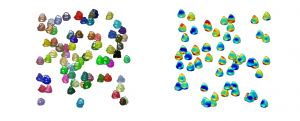Bio
“Change Point Estimation of Brain Shape Data in Relation with Alzheimer’s Disease”
 Laurent Younes is a professor and chair of the Applied Mathematics and Statistics department at Johns Hopkins University. He obtained a bachelor’s degree from Ecole Normale Supérieure in 1984, and a master and doctorate from University of Paris 11 in 1985 and 1988. He was a researcher at CNRS in France from 1990 to 2003 before joining Johns Hopkins University. His research interests include statistical properties of Markov random fields, image analysis, shape analysis, computational anatomy and computational biology.
Laurent Younes is a professor and chair of the Applied Mathematics and Statistics department at Johns Hopkins University. He obtained a bachelor’s degree from Ecole Normale Supérieure in 1984, and a master and doctorate from University of Paris 11 in 1985 and 1988. He was a researcher at CNRS in France from 1990 to 2003 before joining Johns Hopkins University. His research interests include statistical properties of Markov random fields, image analysis, shape analysis, computational anatomy and computational biology.
 Click here to view webcast.
Click here to view webcast.
Abstract
“Change Point Estimation of Brain Shape Data in Relation with Alzheimer’s Disease”
 The manifestation of an event, such as the onset of a disease, is not always immediate and often requires some time for its repercussions to become observable. Slowly progressing diseases, and in particular neuro-degenerative disorders such as Alzheimer’s disease (AD), fall into this category. The manifestation of such diseases is related to the onset of cognitive or functional impairment and, at the time when this occurs, the disease may have already had been affecting the brain anatomically and functionally for a considerable time. We consider a statistical two-phase regression model in which the change point of a disease biomarker is measured relative to another point in time, such as the manifestation of the disease, which is subject to right-censoring (i.e., possibly unobserved over the entire course of the study). We develop point estimation methods for this model, based on maximum likelihood, and bootstrap validation methods. The effectiveness of our approach is illustrated by numerical simulations, and by the estimation of a change point for atrophy in the context of Alzheimer’s disease, wherein it is related to the cognitive manifestation of the disease.
The manifestation of an event, such as the onset of a disease, is not always immediate and often requires some time for its repercussions to become observable. Slowly progressing diseases, and in particular neuro-degenerative disorders such as Alzheimer’s disease (AD), fall into this category. The manifestation of such diseases is related to the onset of cognitive or functional impairment and, at the time when this occurs, the disease may have already had been affecting the brain anatomically and functionally for a considerable time. We consider a statistical two-phase regression model in which the change point of a disease biomarker is measured relative to another point in time, such as the manifestation of the disease, which is subject to right-censoring (i.e., possibly unobserved over the entire course of the study). We develop point estimation methods for this model, based on maximum likelihood, and bootstrap validation methods. The effectiveness of our approach is illustrated by numerical simulations, and by the estimation of a change point for atrophy in the context of Alzheimer’s disease, wherein it is related to the cognitive manifestation of the disease.
This work is a collaboration with Marilyn Albert, Xiaoying Tang and Michael Miller, and was partially supported by the NIH.
 Click here to view webcast.
Click here to view webcast.